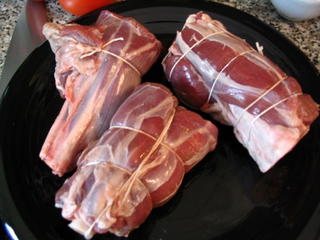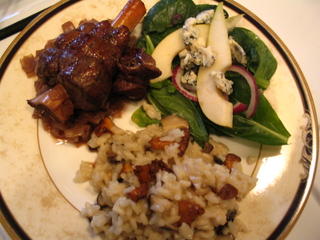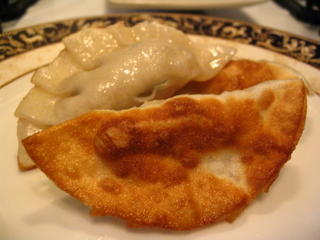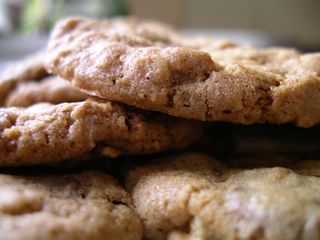The possibilities are darn near endless, especially given the diverse regions in such a geographically large country. I was honoured to be invited to participate
(thanks, Ana and Jennifer!) in the
Taste Canada event started by Jennifer of
Domestic Goddess, and immediately set about trying to figure out this very question. What does Canada taste like, to me?
Salmon is one of the biggies in my region, south western British Columbia, as is Chinese food - thanks to a large and thriving living Chinatown district. While these items do speak to me of the particular collision of resource and culture that colours my city, I wanted to reach beyond the most obvious conclusions.
People in Vancouver seem particularly enthused by the "grow local" movement that is occuring all up and down the west coast, but we also embrace a fierce sort of pride in our artisanal products: small bakeries, cheeseworks, and other family-run food businesses. I decided to make that my focus.
Saltspring Island has been famous for its lamb for some time now, and is gaining an increasing reputation for producing fine cheese, as well. With this as my starting point, I chose a dinner of lamb shanks braised in BC red wine, accompanied by wild mushroom and goat cheese risotto and a spinach, pear and blue cheese salad.
My usual source for Saltspring Island lamb was fresh out of shanks - my fault for trying to source them right before an enormous Greek festival in my neighbourhood. I eventually tracked some down, but since the butcher was not my usual one I found myself doing a fair amount more trimming than usual. The wine I chose was the first acceptable Pinot Noir that I've had from BC, and is surprisingly affordable: the vaguely named Okanagan Vineyards Pinot Noir. This was also the wine that we drank alongside dinner.
 Lamb Shanks in Red Wine
Lamb Shanks in Red Wine
4 lamb shanks
2 large onions, peeled and diced medium (divided)
2 bay leaves
2 cups of red wine - preferably a Pinot Noir, if you can find an affordable, tolerable one, or other light red wine with good acids (a chianti might do it, don't use Merlot or Shiraz)
1 cup strong chicken stock
salt & pepper
Carefully trim 4 lamb shanks of excess skin, membrane and fat. Tie with butchers twine to keep the meat on the bone during and after the braising process. Season lightly with salt and pepper. In a heavy, cast iron frying pan, sear the shanks to a dark, golden brown colour on all sides.
Place half of the chopped onions in a lidded braising dish or small roaster. Lay the seared shanks on top of the onions.
Add a little olive oil to the frying pan that you used for searing, and add the rest of the onions. Cook until translucent, sprinkling with a little salt and black pepper.
Add 1 cup of the wine and scrape the pan to free up the good flavours in the fond left from the searing process, and then pour the onions and wine over the shanks.
Add the rest of the wine, the stock and the bayleaves. Place braising pan on the burner and bring up to a simmer. Place in a 300 F oven for two hours, which gives you lots of time to have a drink and mess around with the rest of the meal.
When ready to serve, remove the shanks to a serving platter, and strain the wine and juices. You can use the reserved onion bits, pink with wine, to act as a bed for the lamb shanks, if you like.
Pour the braising liquid into a shallow pan and reduce over a high heat while you finish preparing the rest of the meal and pour wine for drinking. Spoon the reduced sauce gently over the shanks and serve.

The mushroom and goat cheese risotto featured BC wild mushrooms - specifically shiitake and chanterelles. The goat cheese, stirred in right at the end, was the Saltspring Island Cheese company's Chevre with basil - tangy and assertive. I used my usual
wild mushroom risotto recipe, but without the dried mushrooms, and instead of stirring in butter at the end, that is where I added the Chevre. The flavours were brighter and slightly less earthy than the usual recipe, but just as silky. The mushrooms were purchased at
Choices, a chain that focuses on organically grown, local products as much as possible.
The salad was baby spinach leaves with red onion, tossed with a miniscule amount of walnut oil vinaigrette and topped with slices of pear (representing the fruit orchards in the Okanagan) and another BC artisanal cheese - this one a Tiger Blue cheese from
Poplar Grove in Penticton. Poplar Grove is a unique company, in that they make wine as well as cheese.
To round things out, I picked up a loaf of Black Olive Bread from Terra Breads, our local and somewhat internationally renowned bakery specializing in rustic, chewy crusts. This proved to be the perfect vehicle for the marrow for the lamb shanks.
The lamb turned out just exactly as I wanted - tender, full of flavour, and with an almost unctuous lip-smacking texture. The use of the same wine that we were drinking by the glass meant that the flavours flowed quite harmoniously from one to the other. We had a lovely dinner with the friend whose camera I used to take these photos - yet another example of my thriving "will exchange food for goods or services" scheme!
At the end of the night - was this Canada to me? Yes - in part. The sheer number of amazing foods and cultural traditions that have taken root in Canada are impossible to cram into one dinner, but this meal reflected some of the cultural sensibilities of my city, the Greek influence of my neighbourhood, and the Canadian willingness to mix up the flavours of our various heritages (European, in my case) into a new and delicious way.




























